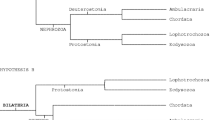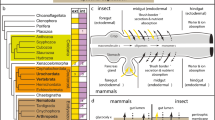Abstract
Interest in the study of Xenacoelomorpha has recently been revived due to realization of its key phylogenetic position as the putative sister group of the remaining Bilateria. Phylogenomic studies have attracted the attention of researchers interested in the evolution of animals and the origin of novelties. However, it is clear that a proper understanding of novelties can only be gained in the context of thorough descriptions of the anatomy of the different members of this phylum. A considerable literature, based mainly on conventional histological techniques, describes different aspects of xenacoelomorphs’ tissue architecture. However, the focus has been somewhat uneven; some tissues, such as the neuro-muscular system, are relatively well described in most groups, whereas others, including the digestive system, are only poorly understood. Our lack of knowledge of the xenacoelomorph digestive system is exacerbated by the assumption that, at least in Acoela, which possess a syncytial gut, the digestive system is a derived and specialized tissue with little bearing on what is observed in other bilaterian animals. Here, we try to remedy this lack of attention by revisiting the different studies of the xenacoelomorph digestive system, and we discuss the diversity present in the light of new evolutionary knowledge.



Similar content being viewed by others
References
Achatz JG, Martinez P (2012) The nervous system of Isodiametra pulchra (Acoela) with a discussion on the neuroanatomy of the Xenacoelomorpha and its evolutionary implications. Front Zool 9(1):27. https://doi.org/10.1186/1742-9994-9-27
Achatz JG et al (2013) The Acoela: on their kind and kinships, especially with nemertodermatids and xenoturbellids (Bilateria incertae sedis). Org Divers Evol 13(2):267–286. https://doi.org/10.1007/s13127-012-0112-4
Andrikou C, Thiel D, Ruiz-Santiesteban JA, Hejnol A (n.d.) Excretion through digestive tissues predates the evolution of excretory organs. bioRxiv (136788)
Arboleda E et al (2018) An emerging system to study photosymbiosis, brain regeneration, chronobiology, and behavior: the marine Acoel Symsagittifera roscoffensis. BioEssays 40(10):e1800107. https://doi.org/10.1002/bies.201800107
Arroyo AS et al (2016) Hidden diversity of Acoelomorpha revealed through metabarcoding. Biol Lett 12(9). https://doi.org/10.1098/rsbl.2016.0674
Baguñà J, Riutort M (2004) The dawn of bilaterian animals: the case of acoelomorph flatworms. BioEssays 26(10):1046–1057. https://doi.org/10.1002/bies.20113.
Beltagi S, Mandura AS (1991) Hofstenia arabiensis Nov . Sp . ( Hofsteniidae ): a new species of Acoelan Turbellaria from the Red Sea north of J eddah. JKAU: Sci 3:65–90
Bery A et al (2010) Structure of the central nervous system of a juvenile acoel, Symsagittifera roscoffensis. Dev Genes Evol 220(3–4):61–76. https://doi.org/10.1007/s00427-010-0328-2
Børve A, Hejnol A (2014) Development and juvenile anatomy of the nemertodermatid Meara stichopi (bock) Westblad 1949 (Acoelomorpha). Front Zool 11:50. https://doi.org/10.1186/1742-9994-11-50
Bourlat SJ et al (2008) Feeding ecology of Xenoturbella bocki (phylum Xenoturbellida) revealed by genetic barcoding. Mol Ecol Resour 8(1):12–22. https://doi.org/10.1111/j.1471-8286.2007.01959.x
Buckland-Nicks, J., Lundin, K. Wallberg A (2019) The sperm of Xenacoelomorpha revisited: implications for the evolution of early bilaterians. https://doi.org/10.1007/s00435-018-0425-8
Corrêa DD (1960) Two new marine Turbellaria from Florida. Bull Mar Sci Gulf Carrib 10:208–216
Crezée M, Tyler S (1976) Hesiolicium gen.N. (Turbellaria Acoela) and observations on its ultrastructure. Zool Scr 5(1–4):207–216. https://doi.org/10.1111/j.1463-6409.1976.tb00700.x
Dorey AE (1965) ‘The organization and replacement of the epidermis in acoelous turbellarians.’, Q. J Microsc Sci 106:147–172
Drobysheva IM (1986) Physiological regeneration of the digestive parenchyma in Convoluta convoluta and Oxyposthia praedator (Turbellaria, Acoela). Hydrobiologia 132(1):189–193
Ehlers U (1992a) Dermonephridia--modified epidermal cells with a probable excretory function in Paratomella rubra (Acoela, Plathelminthes). Microfauna Mar 7:253–264
Ehlers U (1992b) On the fine structure of Paratomella rubra Rieger & Ott (Acoela) and the position of the taxon Paratomella Dörjes in a phylogenetic system of the Acoelomorpha (Plathelminthes). Microfauna Mar 7:265–293
Faubel A, Dörjes J (1978) Flagellophora apelti gen.N. sp.n.: a remarkable representative of the order Nemertodermatida (Turbellaria: Archoophora). Senckenb Marit 10:1–13
Haszprunar G (2015) Review of data for a morphological look on Xenacoelomorpha (Bilateria incertae sedis). Org Divers Evol 16(2):363–389. https://doi.org/10.1007/s13127-015-0249-z
Hejnol A (2015) Acoelomorpha and Xenoturbellida. In: Wanninger A (ed) Evolutionary developmental biology of invertebrates vol. 1. Springer, Vienna, pp 203–214
Hejnol A (2016) Acoelomorpha. In: Structure and evolution of invertebrate nervous systems. Andreas Schmidt-Rhaesa, Steffen Harzsch, Günter Purschke. Oxford University Press, Oxford, pp 56–62
Hejnol A, Pang K (2016) Xenacoelomorpha’s significance for understanding bilaterian evolution. Curr Opin Genet Dev:48–54. https://doi.org/10.1016/j.gde.2016.05.019
Henry JQ, Martindale MQ, Boyer BC (2000) The unique developmental program of the acoel flatworm, Neochildia fusca. Dev Biol 220(2):285–295. https://doi.org/10.1006/dbio.2000.9628
Hooge M et al (2007) A revision of the systematics of panther worms (Hofstenia spp., Acoela), with notes on color variation and genetic variation within the genus. Hydrobiologia 592(1):439–454. https://doi.org/10.1007/s10750-007-0789-0
Israelsson O (1999) New light on the enigmatic Xenoturbella (phylum uncertain): ontogeny and phylogeny. Proc R Soc B Biol Sci 266:835. https://doi.org/10.1098/rspb.1999.0713
Israelsson O (2006) Observations on some unusual cell types in the enigmatic worm Xenoturbella (phylum uncertain). Tissue Cell 38(4):233–242. https://doi.org/10.1016/j.tice.2006.05.002
Israelsson O (2007) Chlamydial symbionts in the enigmatic Xenoturbella (Deuterostomia). J Invertebr Pathol 96(3):213–220. https://doi.org/10.1016/j.jip.2007.05.002
Ivanov AV, Mamkaev YV (1977) Über die Struktur des Digestionsparenchyms bei Turbellaria Acoela. Acta Zool Fenn 154:59–61
Jennings JB (1957) Studies on feeding, digestion, and food storage in free-living flatworms (Platyhelminthes: Turbellaria). Biol Bull 112(1):63–80. https://doi.org/10.2307/1538879
Jondelius U, Wallberg A, Hooge M, Raikova OI (2011) How the worm got its pharynx: phylogeny, classification and bayesian assessment of character evolution in acoela. Syst Biol 60(6):845–871. https://doi.org/10.1093/sysbio/syr073
Karling T (1967) Zur Frage von dem systematischen Wert der Kategorien Archoophora und Neoophora (Turbellaria). Comment Biol Soc Sci Fenn 30(3):1–11
Karling TG (1974) On the anatomy and affinities of the turbellarian orders. In: Riser NW, Morse MP (eds) Biology of the Turbellaria. McGraw-Hill, New York, pp 1–16
Kjeldsen KU et al (2010) Two types of endosymbiotic bacteria in the enigmatic marine worm Xenoturbella bocki. Appl Environ Microbiol 76(8):2657–2662. https://doi.org/10.1128/AEM.01092-09
Klima J (1967) Zur Feinstrucktur des acoelen Süsswasserturbellars Oligochoerus limnophilus (Ax & Dörjes). Ver Naturwiss-Med Ver Innsb 55:107–124
Kozloff EN (1972) Selection of food, feeding, and physical aspects of digestion in the Acoel Turbellarian Otocelis luteola. Trans Am Microsc Soc 91(4):556–565. https://doi.org/10.2307/3225484
Lundin K (2001) Degenerating epidermal cells in Xenoturbella (phylum uncertain), Nemertodermatida and Acoela (Platyhelminthes). Belg J Zool 131(1):153–157
Lundin K, Hendelberg J (1996) Degenerating bodies ("pulsatile bodies") in the epidermis of Meara stichopi (Platyhelminthes, Nemertodermatida). Zoomorphology 116:1–5
Mamkaev YV (1967) ‘Ocherki po morfologii beskishechnykh turbellarij.’, Trudy Zool. Inst AN SSSR Leningrad 44:26–108
Mamkaev YV (1986) Initial morphological diversity as a criterion in deciphering turbellarian phylogeny. Hydrobiologia 132:31–32
Mamkaev YV, Markosova TG (1982) Peculiarities of feeding and digestion of Oxyposthia praedator (Turbellaria, Acoela). Pacific Sci Cong Proceedings 14:97–102
Mamkaev IV, Seravin LN (1963) Feeding of the acoelous turbellarian Convoluta convoluta (Abildgaard). J Zool Zh 47:197–205
Markosova TG (1976) Acid phosphatase activity during digestion in the anintestinal Turbellaria Convoluta convoluta. Zh Evol Biokhim Fiziol 12:183–184
Martinez P, Hartenstein V, Sprecher SG (2017) Xenacoelomorpha nervous systems. In: Sherman SM (ed) Oxford Encyclopaedia of neurosciences. Oxford University Press, Oxford
Meyer-Wachsmuth I, Raikova OI, Jondelius U (2013) The muscular system of Nemertoderma westbladi and Meara stichopi (Nemertodermatida, Acoelomorpha). Zoomorphology 132(3):239–252. https://doi.org/10.1007/s00435-013-0191-6
Meyer-Wachsmuth I, Curini-Galletti M, Jondelius U (2014) Hyper-cryptic marine meiofauna: species complexes in Nemertodermatida. PLoS One 9(9):e107688. https://doi.org/10.1371/journal.pone.0107688
Papi F (1957) Sopra un nuovo Turbellario arcooforo di particolare significato filetico e sulla posizione della fam. Hofsteniidae nel sistema dei Turballari. Pubbl Stn Zool Napoli 30:132–148
Pedersen KJ (1964) ‘the cellular organization of Convoluta convoluta, an acoels turbellarian: a cytological, histochemical and fine structural study'. Zeitschrift für Zellforschung und mikroskopische Anatomie (Vienna Austria, 1948) 64:655–687
Perea-Atienza E et al (2013) Posterior regeneration in Isodiametra pulchra (Acoela, Acoelomorpha). Front Zool 10(1):64. https://doi.org/10.1186/1742-9994-10-64
Philippe H et al (2011) Acoelomorph flatworms are deuterostomes related to Xenoturbella. Nature 470(7333):255–258. https://doi.org/10.1038/nature09676
Raikova OI (1987) Ultrastructural organization of the digestive system of the acoel turbellarian Actinoposthia beklemishevi Mamkaev. [in Russian]. Tr Zool Inst Nauk USSR 167:72–78
Raikova OI et al (2000) An immunocytochemical and ultrastructural study of the nervous and muscular systems of Xenoturbella westbladi (Bilateria inc. sed.). Zoomorphology. 120(2):107–118. https://doi.org/10.1007/s004350000028
Ramachandra NB et al (2002) Embryonic development in the primitive bilaterian Neochildia fusca: normal morphogenesis and isolation of POU genes Brn-1 and Brn-3. Dev Genes Evol 212(2):55–69. https://doi.org/10.1007/s00427-001-0207-y
Riedl R (1954) Neue Turbellarien aus dem mediterranen Felslittoral. Ergebnisse der “‘Unterwasser-Expedition Austria 1948– 1949’”. Zool Jahrb Syst (Wien) 82:157–244
Riser NW (1987) Nemertinoides elongatus gen.N., sp.n. (Turbellaria: Nemertodermatida) from coarse sand beaches of the western North Atlantic. Proc Helmintol Soc Wash 54(1):60–67
Rouse GW et al (2016) New deep-sea species of Xenoturbella and the position of Xenacoelomorpha. Nature. 530(7588):94–97. https://doi.org/10.1038/nature16545
Semmler H, Bailly X, Wanninger A (2008) Myogenesis in the basal bilaterian Symsagittifera roscoffensis (Acoela). Front Zool 5:1–15. https://doi.org/10.1186/1742-9994-5-14
Sikes JM, Bely AE (2008) Radical modification of the A-P axis and the evolution of asexual reproduction in Convolutriloba acoels. Evol Dev 10(5):619–631. https://doi.org/10.1111/j.1525-142X.2008.00276.x
Smith JPS (1981) Fine-structural anatomy of the parenchyma in the Acoela and Nemertodermatida (Turbellaria). PhD. Thesis. North Carolina, Chapel Hill
Smith JPS III (1981) Fine-structural observations on the central parenchyma in Convoluta sp. Hydrobiologia 84:259–265
Smith J III, Tyler S (1985) The acoel turbellarians: kingpins of metazoan evolution or a specialized offshoot? In: Conway Morris S, George JD, Gibson R, Platt HM (eds) The origins and relationships of lower invertebrates. Clarendon Press, Oxford, p 123142
Srivastava M et al (2014) Whole-body acoel regeneration is controlled by Wnt and bmp-Admp signaling. Curr Biol 24(10):1107–1113. https://doi.org/10.1016/j.cub.2014.03.042
Steinböck O (1930) Ergebnisse einer von E. Reisinger & 0. Steinbock mit Hilfe des Rask- 0rsted Fonds durchgefuhrten Reise in Gronland 1926.2. Nemertoderma buthycola nov. gen. nov. spec., eine eigenartige Turbellarie aus der Tiefe der Diskobay; nebst einem Beitrag zur Kenntnis des Nemertinenepithels. Vidensk Medd Dansk Nuturhist Foren 90:47–84
Sterrer W (1998) New and known Nemertodermatida (Platyhelminthes-Acoelomorpha): a revision. Belgian J Zool 128(1):55–92
Todt C (2009) Structure and evolution of the pharynx simplex in acoel flatworms (Acoela). J Morphol 270(3):271–290. https://doi.org/10.1002/jmor.10682
Tyler S, Rieger RM (1977) Ultrastructural evidence for the systematic position of the Nemertodermatida (Turbellaria). Acta Zool Fennica 54:193–207
Westblad E (1940) Studien über skandinavische Turbellaria Acoela. Arkiv för Zoologi 32A(20):1–28
Westblad E (1949a) On Meara stichopi (Bock) Westblad, a new representative of Turbellaria Archoophora. Ark Zool, Ser 2 1(5):43–57
Westblad E (1949b) Xenoturbella bocki n.g., n. sp., a peculiar, primitive turbellarian type. Ark Zool 1:3–29
Acknowledgments
We would like to thank Dr. Olga Raikova (Saint Petersburg, Russia) for helping us clarifying some ultrastructural details of the Acoela that were needed for this review. Prof. Julian P.S. Smith III (Winthrop University, USA) kindly sent us a copy of his, comprehensive, PhD thesis on acoel digestive systems. Dr. Kennet Lundin (Gothenburg Natural History Museum, Sweden) was also instrumental in helping us to understand some aspects of the nemertodermatids’ digestive system.
The Meara stichopi stained section was provided by Dr. John Buckland-Nicks (Antigonish, Nova Scotia, Canada). Sections of Xenoturbella bocki were obtained from Michaela Egertova and Dr. Maurice Elphick (London, UK) and processed in house.
We would like to thank the anonymous referees for helping us to improve the manuscript.
Funding
V: H. would like to acknowledge the financial support provided by the NIH (NIH Grant 1RO1 R01 NS054814 to V.H.). PM and SGS would like to thank the financial support provided by the “KVA fund for internationalization and scientific renewal at the Sven Lovén Centre” that allowed them to collect Xenoturbella specimens in Sweden. In addition, SGS would like to thank the support provided by the COST SNF Grant IZCOZ0_182957.
Author information
Authors and Affiliations
Corresponding authors
Ethics declarations
Conflict of interest
The authors declare that they have no conflict of interest.
Ethical approval
This article does not contain any studies with human participants performed by any of the authors.
Additional information
Publisher’s note
Springer Nature remains neutral with regard to jurisdictional claims in published maps and institutional affiliations.
Rights and permissions
About this article
Cite this article
Gavilán, B., Sprecher, S.G., Hartenstein, V. et al. The digestive system of xenacoelomorphs. Cell Tissue Res 377, 369–382 (2019). https://doi.org/10.1007/s00441-019-03038-2
Received:
Accepted:
Published:
Issue Date:
DOI: https://doi.org/10.1007/s00441-019-03038-2




